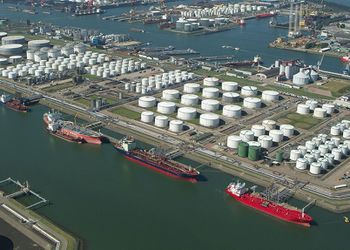Port climate adaptation
Contents
Reduction of greenhouse gas emissions
The contribution of shipping to global greenhouse emissions is close to 3%. Part of these emissions are related to port operations. For example, it is estimated that around 15% of shipping's greenhouse gas (GHG) emissions occur when cargo vessels are in stationary mode, e.g. in port or at anchor[1]. These emissions can be reduced by optimizing the efficiency of port operations. Inactive times can be minimized by utilizing real-time data to dynamically schedule vessel arrivals and departures, optimizing schedules based on factors such as weather conditions[2]. In addition, providing ships at berth with (green) electricity supply eliminates the necessity of running ship engines while docked in ports.
Several other measures contribute to reducing GHG emissions, such as environmental-differentiated port fees and the establishment of low-emission berth zones. Ports may collaborate with energy providers to ensure the availability of low-carbon fuels for vessels equipped for using alternative energies. Offshore (e.g. wind, wave) and inshore (e.g. solar) renewable energy generation can largely cover the energy needs of port operation systems. CO2 emissions from port-related industries can be captured and stored in deep underground reservoirs (CCS) in the nearshore zone[3][4]
Hinterland transport
Port-hinterland transport generates GHG emissions that are on average higher than those of port operation[5]. Creating multimodal platforms that facilitate hinterland transport by rail or river instead of road is therefore a significant climate adaptation measure. Short-sea shipping (along the coast and on inland waterways) can greatly reduce the need for long-distance road transport.
Adaptation to sea level rise
Port infrastructures need to be adapted to sea level rise and other climate-related impacts. New port developments and major maintenance should be designed with future adaptations in mind, such as raising quays. Possibilities for floating infrastructure and nature-based solutions should be explored. Real-time monitoring and early warning systems enable proactive responses to extreme weather, and ongoing research and innovation ensure ports stay ahead of evolving risks[2].
Energy transition
Ports that heavily rely on transshipment of fossil fuels have to prepare for the energy transition. In the next 30 years oil, natural gas and coal will be out phased. Ports must develop strategies to cope with this future and to invest in new economic activities that create added value independent of fossil fuels. For example, first steps are being taken by Rotterdam, a large port still heavily relying on transshipment of fossil fuels[6].
Related articles
References
- ↑ Mjelde, A., Endresen, O., Bjorshol, E., Gierloff, C.W., Husby, E., Solheim, J., Mjos, N. and Eide, M.S. 2019. Differentiating on port fees to accelerate the green maritime transition. Marine Pollution Bulletin 149, 1105
- ↑ 2.0 2.1 Puig, M., Cirera, A., Wooldridge, C., Sakellariadou, F. and Darbra, R.M. 2024. Mega Ports’ Mitigation Response and Adaptation to Climate Change. Mar. Sci. Eng. 12, 1112
- ↑ Cavanagh, A., Haszeldine, S., Palfi, E, Paterson, J., Stevenson, R. and White, G. 2024. Onshore and inshore storage of carbon dioxide. Prepared by SCCS on behalf of ClimateXChange, The University of Edinburgh, pp. 79 DOI: http://dx.doi.org/10.7488/era/4622
- ↑ Global CCS Institute 2024. Global status of CCS 2023 scaling up through 2030. https://www.globalccsinstitute.com/wp-content/uploads/2024/01/Global-Status-of-CCS-Report-1.pdf
- ↑ Alamoush, A.S., Ölçer, A.I. and Ballini, F. 2022. Port greenhouse gas emission reduction: Port and public authorities' implementation schemes. Research in Transportation Business & Management 43, 100708
- ↑ Resource transition. Circular by 2050. https://www.portofrotterdam.com/sites/default/files/2022-07/position-paper-pillar-3.pdf
Please note that others may also have edited the contents of this article.
|
